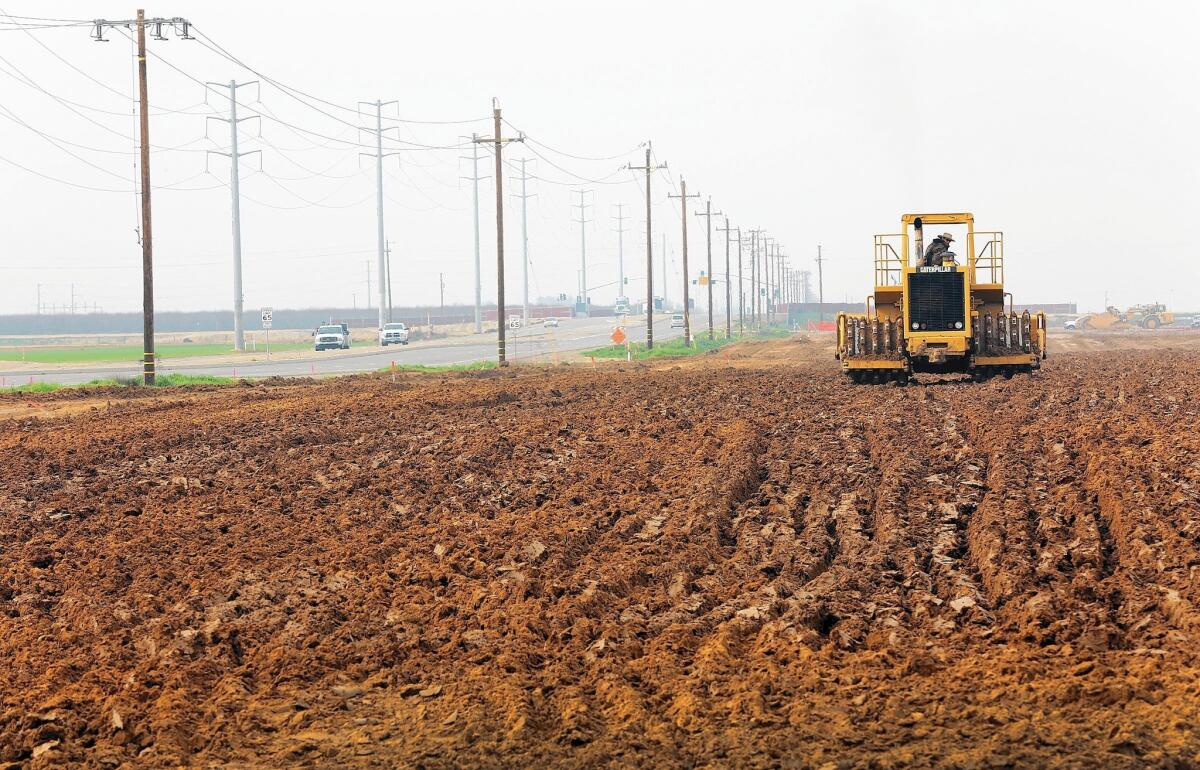First phase of bullet train is cut due to Bakersfield, Shafter disputes

- Share via
State bullet train officials have cut eight miles of track from an initial 130-mile section of construction in the Central Valley as a result of legal disputes with local cities.
Instead of ending in the outskirts of Bakersfield, the rail work will now stop just north of Shafter. A still-pending legal battle also could eliminate a proposed elevated structure that would have carried high-speed trains through Shafter’s downtown.
The California High-Speed Rail Authority says the distance covered by the initial construction plan had to be reduced because of a December agreement that settled a lawsuit brought by Bakersfield officials. The settlement calls for a review of the proposed route through the city.
The change is the latest development stemming from legal disputes over the effects of the massive project on Central Valley counties, cities and farms. Additional meetings and studies of the route could take months.
Lisa Marie Alley, a spokeswoman for the rail authority, said the lawsuits and settlement represent “an evolution of the project,” not complications. The route reconsideration won’t cause an overall delay in the project’s construction, she said, and track eliminated from the current construction effort can be handled in a later contract.
Like in Bakersfield, Shafter officials filed a lawsuit alleging that the authority’s environmental analysis of the proposed route through their town was inadequate. City Manager Scott Hurlbert said the Shafter case contributed to the reconsideration of the Bakersfield alignment because more changes could be in the offing, including to a long section of viaduct.
According to the Bakersfield settlement, the city and the authority must meet with business owners, farmers and other stakeholders to explore a new route through the northern part of the city before it connects to a downtown high-speed rail station a few miles from the existing Amtrak station.
The authority and the city have until January 2016 to reach an agreement on an alignment, unless both parties agree to an extension of the deadline.
“The authority is committed to look at a new conceptual alignment,” Alley said. “We are working with the City Council, the city and the public.”
The change in construction plans emerged publicly last month, when the authority board asked construction companies bidding on a 30-mile track-laying contract to adjust their proposals to 22 miles.
Because of the reduction in work, the estimated cost of $700 million to $900 million was lowered to between $400 million and $500 million.
The Shafter-to-Bakersfield section is a small part of the project’s initial $6-billion construction phase, which includes bridges, viaducts, trenches and the installation of rail, and is expected to be completed by 2017. The electrical system to operate trains would be part of a later project to extend tracks to Merced and Burbank.
Elizabeth Goldstein Alexis, co-founder of a San Francisco Bay Area group that opposes the project, said the contract change represents a significant modification to the state’s plan, but was only vaguely described at a rail authority board meeting.
“There were no maps or discussion of the change,” she said. “They didn’t even name the town where they were stopping.”
Alexis said she believes the cutback was driven in part by budget pressures at the authority — something high-speed rail officials deny. State rail officials say bids on construction contracts for the Central Valley segment have come in under authority cost estimates.
How the state will fully fund the $6-billion initial construction phase is not entirely certain, however.
The federal government has provided grants of $3.2 billion. The amount includes about $2 billion that must be matched with an equal amount of state money that has to be spent by September 2017. Federal funds left unspent after that date would be returned to the U.S. Treasury.
The state has to come up with $2.8 billion, according to its official funding plan, and has $9 billion in bond funding that voters approved in 2008 that could be tapped if certain conditions are met. But that state money is the focus of an ongoing legal challenge by project opponents.
The rail project also has income from carbon emission fees. In the fiscal year that starts in July, the cap-and-trade program is expected to raise an estimated $2 billion, giving the project about $500 million, according to the Legislative Analyst’s Office.
Legislative analysts also predict those revenues will remain fairly level in coming years. That means cap-and-trade funds alone aren’t likely to provide the $2.8 billion in matching funds the rail authority needs by 2017.
More to Read
Sign up for Essential California
The most important California stories and recommendations in your inbox every morning.
You may occasionally receive promotional content from the Los Angeles Times.












